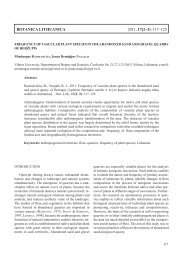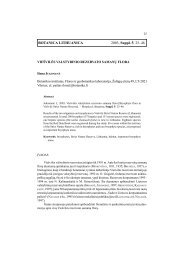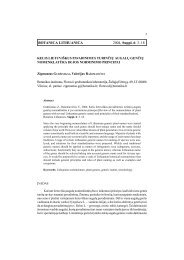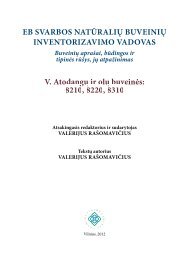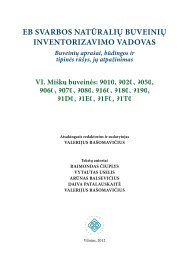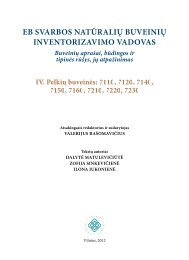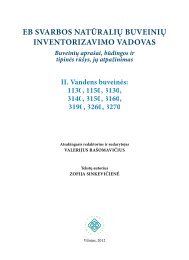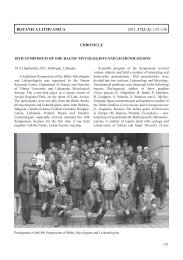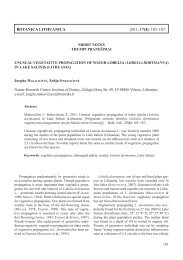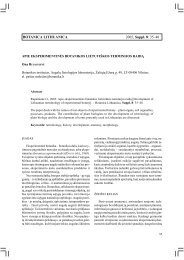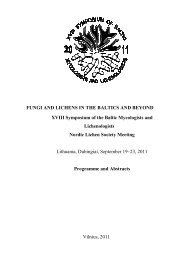BOTANICA LITHUANICA 2005, Suppl. 7: 65–75
BOTANICA LITHUANICA 2005, Suppl. 7: 65–75
BOTANICA LITHUANICA 2005, Suppl. 7: 65–75
- No tags were found...
Create successful ePaper yourself
Turn your PDF publications into a flip-book with our unique Google optimized e-Paper software.
INTRODUCTIONMicrobiological contamination of food and aftereffectsare investigated widely in the world, as microorganismsand metabolites of their functional activity arean important source that causes diseases and death ofhumans, loss of natural resources and human-made products.Diversity of microorganisms, their adaptable abilitiesand variable activities cause a great concern topeople and enforce to know more about this aggressivemicrobial world, control its activity, shift it in a desirableway or limit it. These tasks are being solved. Whileconducting the research program “Mycotoxin”, we encounteredwith a very viable and active group of microorganisms– micromycetes. Their biological propertiescapacitate them to adapt to altering environmental conditionsand deteriorate various substrates of plant origin.Due to their activity huge economical losses are caused –every year about 30 % of plant origin products are utilized.Micromycetes can become a cause of ecological problemsand diseases of plants, birds, animals and humansif sanitary norms are not obeyed. An interest in mycotoxins,secondary fungal metabolic products that can besecreted to the environment, has been growing in theworld (LUGAUSKAS et al., 1997; BOUTRIF & BESSY, 2000;SAMSON et al., 2000; DUTKIEWICZ et al., 2001; LUGAUSKASet al., 2002; PARSHIKOV et al., 2002; TAUXE, 2002; THRA-NE, 2004) and means to reduce their negative effect havebeen searched (MILJKOVIC et al., 2003; MANTLE, 2004;TOMA et al., 2004). To solve tasks of this problem, it isaimed to find out micromycetes – the most active producersof mycotoxins, to determine factors influencingspreading of micromycetes and their ability to producemycotoxins, to search or develop a complex of meansenabling to limit or suppress spreading of micromycetesand their functional abilities.The main task of the investigation was to study thediversity of micromycetes in food originated from Lithuaniaand abroad, to detect the most active producers oftoxic compounds, and to ascertain capability of theseto accumulate mycotoxins under various conditions.MATERIALS AND METHODSIsolation and identification of micromycetes. Samplesof grain, seeds, fruit, vegetables and food productsof plant origin were analyzed according to KUDRJAÐEVA(1986), ANDREWS et al. (1997), RABIE et al. (1997) andSAMSON et al. (2000). Fungi were isolated on standardCzapek, Malt Extract Agar (MEA) media. Isolates wereascribed to taxonomic groups following Ainsworth andBisby’s Dictionary of the Fungi (HAWKSWORTH et al.,1995). Micromycetes were identified according to RAP-ER et al. (1965), GAMS (1971), ELLIS (1971, 1976), BOE-REMA & DORENBOSCH (1973), MIL’KO (1974), DOMSCH etal. (1980), PLAATS-NITERINK (1981), RAMIREZ (1982),NELSON et al. (1983), BRANDENBURG (1985), LUGAUSKASet al. (1997), SAMSON et al. (2000). For micromycetes ofFusarium graminearum, F. culmorum, F. avenaceum,F. poae, important in toxigenic respect, identificationwas confirmed by PCR-based technique according toPARRY & NICHOLSON (1996), SCHILLING et al. (1996),DOOHAN et al. (1998) and NICHOLSON et al. (1998).Production of toxins. Screening of micromycetesaccording to their ability to produce toxic metaboliteswas performed by thin-layer chromatography (TLC,ISO standard 8178: 1999). Micromycetes were grownfor 20–25 days on Czapek Yeast Extract (CYA), YeastExtract Sucrose (YES), and standard Czapek agar media(FRISVALD & THRANE, 2000; SAMSON et al., 2000). Briefly,agar plug with mycelium about 8 mm in diameter wascut out of the colony and extracted with 1 ml chloroform/methanolmixture (2 : 1) overnight. The productionof secondary metabolites is usually the highest in thecentre of colony. After extraction 20 µl of extract wasplaced onto TLC plates. For this analysis precoatedplates of silica gel (20 by 20 cm, 0.20 mm thick; Macherey-Nagel)containing a fluorescence indicator (F254)or no indicator were used. The following solvent systemswere chosen: chloroform-methanol (95 : 5) (CHM);toluene-ethyl-acetate-formic acid (5 : 4 : 1) (TEF); benzene-aceticacid (9 : 1) (BAC); toluene-acetone-methanol(5 : 3 : 2) (TAM). After elution and drying, the TLCplates were examined in visible light and in UV-light(UV 254/366 nm). The Rf (a distance of a derivativefrom the start line/a distance of a solvent system fromthe start line) of metabolites was evaluated. Amountsof mycotoxins in different food and grain samples weredetermined by the imunoenzyme analysis method(ELISA). For this purpose, commercial kits Veratox®Alatox(Total), Veratox®Don 5/5, Veratox®Ochratoxin,Veratox®Aflatoxin, T–2 toxin and Zearalenone wereused. Mycotoxins were detected following the manufacturer’sinstructions (R-Biopharm AG, Germany).RESULTS AND DISCUSSIONThe number of humans affected by mycoses and mycotoxicosesis known around the world. Although thetotal number affected is believed to be less than the numberaffected by bacterial, protozoan and viral infections,66



